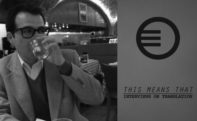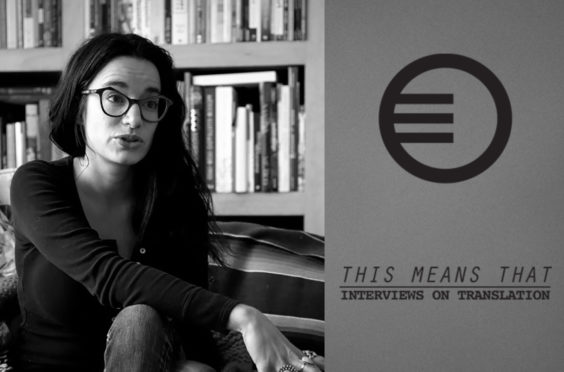
Por Interview by Brenda Lozano, Spanish to English Translation by Ana Isabel Martínez

Brenda Lozano: What book or story led you to English?
Gabriela Jauregui: Maurice Sendak’s and Richard Scarry’s children’s books, as well as the Muppets and Sesame Street, all led me to English. My grandmother and mother led me by speaking to me in English since I was a kid (the border led them to it, my grandmother was from Coahuila and was raised both here and there. My mother was raised the same way and she raised me the same way, and voilà!).
Tell us about your first translation.
My first translation was in my neighbor’s house as I tried to explain to my neighbor-friend that the galleta I wanted was a cookie. After that, I didn’t stop. They gave us translation exercises at school. My first book translation project was Mes hypertropes from the Oulipian Paul Braffort, which I translated with my colleague and friend Amaranth Borsuk from French to English. And from then on, p’al real, as they say. The truth is that I live in perpetual translation.
Is translation a way to get closer or move away from the original text?
The answer could be something like the title of that movie from my teenage years, Faraway, So Close! I think that in translation, and in some types of dances, you have to know how to move away to get closer.
How faithful are you to the original? How would you describe that fidelity, as being more literal, more conceptual?
Just as with proximity and distance, fidelity is more conceptual for me. Sometimes by being less faithful, less literal, farther away, you can be truer to the tone, the voice, the intention. Translation is not a science, it’s an art and in every art there’s training, there’s technique, but there’s also a high percentage of sentimiento (understood as probing, as feeling and as a sixth—text?—sense).
Is there a metaphor, some lines or verses that depict your idea of translation?
There are classical texts such as Benjamin’s, the one from Ortega y Gasset, or the one from Borges that inspire translation, but the line that depicts this relationship with translation (and yes, every translation is a relationship) for me is: “I have but one language, yet that language is not mine” (Jacques Derrida, Monolingualism of the Other).
Does translation exist only within the confines of language or are there other forms of translation whose materiality aren’t words?
Given that language itself can be understood in various forms (written, oral, visual, musical, etc.), translation is never limited to the written language, or to words. As I was saying before, I live in constant translation: whether it’s from analog to the 0s and 1s of the digital (I write shorthand, then transcribe to my computer), from one virtual communication media to another (WhatsApp to Instagram, Gmail to Facebook, etc), or the most classical translation of one language to another (between Spanish, French and English), and I also translate written things to songs, visual things to written things. I believe that, as showcased in Greece’s buses—metaphora—, we all live in metaphor, traveling from one place to the other, in other words, in movement, in translation.
¿Qué libro o qué historia te llevó al Inglés?
Me llevaron los libros de niños de Maurice Sendak y Richard Scarry, me llevaron los Muppets y Sesame Street. Me llevaron mi abuela y mi madre que desde niña me hablaban en inglés (a ellas las llevó la frontera, mi abuela era de Coahuila y se crió aquí y allá y así crió a mi madre y ella así me crió a mí, voilà!)
Háblanos de tu primera traducción.
Mi primera traducción fue en casa de mis vecinos al tratar de explicarle a mi vecino-amigo que la cookie que quería era una galleta. Después de eso, no paré. En la escuela nos ponían ejercicios de traducción. Mi primer proyecto de traducción de libro fue Mes hypertropes del Oulipiano Paul Braffort, que traduje con mi amiga y colega Amaranth Borsuk del francés al inglés. Y de allí p’al real, como dicen. La verdad es que vivo en traducción perpetua.
¿Es la traducción una forma de acercarse o una forma de alejarse del texto original?
La respuesta podría ser algo así como el título de aquella película de mi adolescencia, Faraway, So Close! Creo que en traducción, y en algunos tipos de bailes, hay que saber alejarse para poder acercarse.
¿Qué tan fiel eres al original? ¿Cómo caracterizarías esa fidelidad, ¿más literal, más conceptual?
Al igual que con la distancia y la cercanía, la fidelidad para mí es algo más conceptual. A veces entre menos fiel se es, menos cercano, menos literal, más fiel logras ser al tono, a la voz, a la intención. La traducción no es una ciencia, es un arte y como en todo arte hay entrenamiento, hay técnica, pero también hay un alto porcentaje de feeling (entendido como tanteo, como sentimiento y como sexto—¿texto?—sentido).
¿Hay alguna metáfora, algunas frases o versos que retraten tu idea de la traducción?
Hay textos clásicos como los de Benjamin, el de Ortega y Gasset y el de Borges que inspiran a la traducción, pero para mí la frase que más retrata esta relación con la traducción (y sí, toda traducción es una relación) es: “No tengo más que una lengua, no es la mía” (Jacques Derrida, El monolingüismo del otro).
¿La traducción sólo existe en los confines del lenguaje o hay otras formas de traducción cuyo material no sean las palabras?
Como el lenguaje mismo puede ser entendido de varias formas (escrito, oral, visual, musical etc.) la traducción nunca se limita al lenguaje escrito, o a la palabra. Como te decía, yo vivo en traducción constante: ya sea de lo análogo a los 0’s y 1’s de lo digital (escribo a mano, transcribo en computadora), de un medio a otro de comunicación virtual (whatsapp a instagram, gmail a Facebook, etc), la más clásica traducción de un idioma a otro (entre el español, el francés y el inglés), y también hago traducciones de algo escrito a algo cantado, de algo visual a algo escrito. Creo que, como bien lo indica la palabra en los autobuses en Grecia—metaphora—, todos vivimos en metáfora, transportando de un lugar a otro, en translación, es decir en movimiento, en traducción.
Gabriela Jauregui holds a PhD in Comparative Literature from the University of Southern California. She’s the author of Controlled Decay (NY: Akashic Books, 2008), co-author of Taller de taquimecanografía (DF: Tumbona Ediciones, 2012), and has translated El tiempo se volvió cuero (Oaxaca: sur+ ediciones, 2009) from the English poet Tom Raworth, as well as My Hypertropes 21+1 Programmatic Poems, from the Oulipian poet Paul Braffort. She has also translated several contemporary artists’ catalogues for different museums and institutions, and is the co-founder and co-editor of the sur+ ediciones collective.
Brenda Lozano was born in Mexico City. A narrator and essayist, she contributes to Letras Libres and Día Siete, among other publications. Her newest work, Cómo piensan las piedras, was released in 2017 from ALFAGUARA. She is the Spanish Language Editor for MAKE and Co-Director of the Lit & Luz Festival.
Jose Antonio Villarán was born in Lima, Perú. He is the author of el cerrajero (Album del Universo Bakterial, 2012). In 2008 he created the AMLT project, an exploration of hypertext literature and collective authorship; the project was sponsored by Puma from 2011-2014. His third book, titled open pit, is forthcoming from AUB (Lima). He is currently a PhD student of Literature at the University of California-Santa Cruz.
Gabriela Jauregui tiene un doctorado en Literatura Comparativa por la Universidad del sur de California. Ella es autora de Controlled Decay (NY: Akashic Books, 2008) y coautora de Taller de taquimecanografía (DF: Tumbona Ediciones, 2012) y ha traducido El tiempo se volvió cuero (Oaxaca: sur+ ediciones, 2009) del poeta inglés Tom Raworth así como My Hypertropes 21+1 Programmatic Poems del miembro del OuLiPo, Paul Braffort. Además ha traducido varias catálogos de artistas contemporáneos para distintos museos e instituciones y es cofundadora y coeditora del colectivo sur+ ediciones.
Brenda Lozano nació en la ciudad de México. Es narradora and ensayista. Colabora con Letras Libres y Día Siete, entre otras publicaciones. Su libro, Cómo piensan las piedras, fue publicado en 2017 por ALFAGUARA. Es editora para MAKE Magazine y también es Co-Directora del Lit & Luz Festival.
José Antonio Villarán nació en Lima, Perú. Es el autor de el cerrajero (Album del Universo Bakterial, 2012). En 2008 creyó el proyecto AMLT, una exploración de literatura de hypertext y autoridad colectiva; el proyecto fue patrocinado por Puma de 2011-2014. Su tercer libro, open pit, viene por AUB (Lima). Villarán está matriculado en el programa de doctorado en Literatura de la Universidad de California-Santa Cruz.















click to see who
MAKE Magazine Publisher MAKE Literary Productions Managing Editor Chamandeep Bains Assistant Managing Editor and Web Editor Kenneth Guay Fiction Editor Kamilah Foreman Nonfiction Editor Jessica Anne Poetry Editor Joel Craig Intercambio Poetry Editor Daniel Borzutzky Intercambio Prose Editor Brenda Lozano Latin American Art Portfolio Editor Alejandro Almanza Pereda Reviews Editor Mark Molloy Portfolio Art Editor Sarah Kramer Creative Director Joshua Hauth, Hauthwares Webmaster Johnathan Crawford Proofreader/Copy Editor Sarah Kramer Associate Fiction Editors LC Fiore, Jim Kourlas, Kerstin Schaars Contributing Editors Kyle Beachy, Steffi Drewes, Katie Geha, Kathleen Rooney Social Media Coordinator Jennifer De Poorter
MAKE Literary Productions, NFP Co-directors, Sarah Dodson and Joel Craig